Foam Rolling for Climbers
Foam rolling is a form of self-massage / myofascial release using either a foam roller, balls or massage sticks. Foam rolling has many mechanical, physiological and neurological effects which benefit training and performance. Foam rolling before performance (Pre-Rolling) has been shown to improve short term flexibility and improvements in sprint performance. Foam rolling after the session (Post-Rolling) improves recovery from strength and power activities.
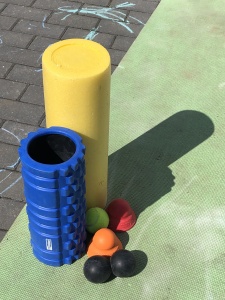
Foam rolling tools
The method is to start off gently and slowly on the targeted area rolling backwards and forwards. When you find a sore or painful spot massage this area for 20-30 seconds. Foam rolling is best done at the start of the session when you’ve done your initial warm-up (Pre-rolling). As with flexibility you want to be as relaxed as possible breathing deeply through the nose and out the mouth.
Foam rolling should be used before a mobility session to help access greater range of motion or before a strength session to improve performance. The following is a guide to key areas which are beneficial for climbers to foam roller before a session or post session to aid recovery. There is a lot of individualisation within foam rolling depend on what muscles need releasing / massaging for you. The rolls below are a good starting point, they can be made much more specific and there is an exhaustive number of variations and details that can be applied.
As with all exercise if in doubt speak to a qualified health professional.
Upper Body Foam Rolling
Chest
For the pecs a door frame of similar also works well. Place the ball in the top distal part of the pec as in the picture, now with your arm against the wall slide the elbow up and down the wall. Adjust the ball looking for tight / sore spots.
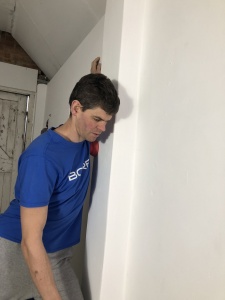
Pec Acumobility ball self massage
Lat and upper back
Starting on your side with the foam roller tucked under your armpit, roll away from your arm down the side of your back and back to your armpit. You should be rolling up and down your Latissimus Dorsi (Lat), if you come across a tight patch spend a bit longer rolling in this area.
For your upper back roll a bit more onto your back and roll up and down your scapular, this will target a number of your rotator cuff muscles. As with the Lat, roll gently until you find a tight spot and then pause and roll further here.
You can also you a lacrosse ball into the scapular area and also between your scapular for your lower and middle trapezius muscles. In these pictures I use a Foam Roller and an Acumobility ball.
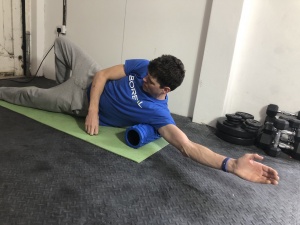
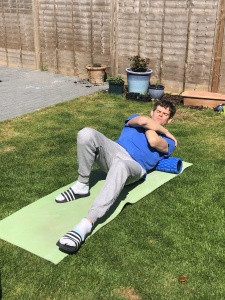
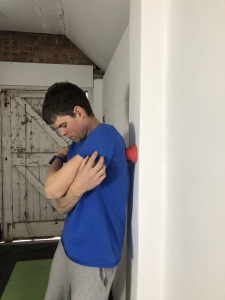
Lat, upper back foam rolling and upper back ball self massage
Upper Traps
For the upper traps find a door frame or structure which gives your head space so you can get your shoulder in the massage ball. Place the ball (I use an Acumobility ball for this) on the wall or structure and lean into it so it presses into your upper trap as in the picture. Move around till you find a tight or sore patch and then work that area for 30 seconds before moving on.
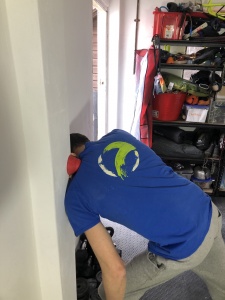
Upper Trap Acumobility self massage
Lower Back
Using a foam roller start just above your hips and leaning slightly to one side roll up to your ribs and back down then swap sides. Note, we don’t recommend you directly roll the lumbar spine unless recommended by a qualified health professional. Here we are trying to roll the muscles on the side of the back and Quadratus Lumborum.
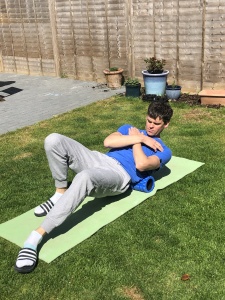
Lower back foam rolling
Legs and Hips Foam Rolling
Hamstring
Sitting up with your hands supporting yourself place the foam roller underneath your hamstring so one leg is fully supported on the foam roller. Lift the other leg off the ground and roll backwards and forwards slowly, also lean slightly to the side to get different angles on the muscles to find those tight spots. If you need to decrease the pressure put the other foot back on the ground.
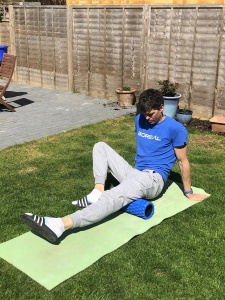
Foam rolling the hamstring
Quadriceps
Lying on your front with the upper part of one leg resting on the foam roller lift the other leg off the ground and roll gently backwards and forwards, also lean slightly to the side to get different angles on the muscles to find those tight spots. If you need to decrease the pressure put the other foot back on the ground.
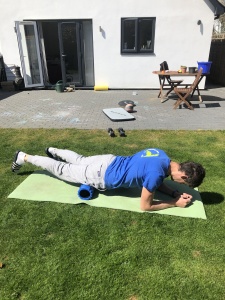
Foam rolling the quadricep muscles
Calves
In a sitting position with your hands supporting your body place the foam roller under your calves and raise the other leg off the ground. Slowly roll backwards and forwards, also lean slightly to the side to get different angles on the muscles to find those tight spots. If you need to decrease the pressure put the other foot back on the ground.
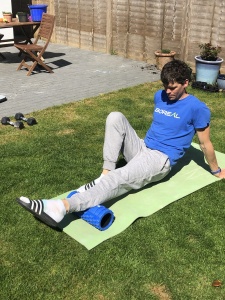
Foam rolling the calves
Glutes
Sitting on top of the foam roller so it sits in the middle of your glutes. Place your hands on the ground to support yourself then roll backwards and forward. Try adjusting the angle you are sitting on the foam roller and working all around the hips / glutes areas. Adjust the pressure by lifting the foot off the ground to increase or bringing closer to you to decrease.
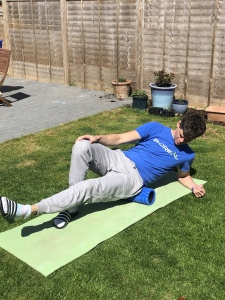
Foam rolling the glutes
Links
A few links.
Further Reading – A Meta-Analysis of the Effects of Foam Rolling on Performance and Recovery
Acumobility Ball – Our favourite tools